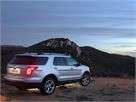Recent Articles
Popular Makes
Body Types
10 Things You Should Know About the 2011 Ford Explorer
Ford rethinks the midsize SUV.
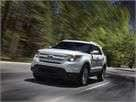
In 2002, Ford sold more than 430,000 Explorers. This macho trucky SUV, often featuring V8 power, was a big hit with American families, becoming the de facto station wagon of a generation. Sales declined every year thereafter, then fell off the cliff after the fuel-price spike of 2008. As Americans turned to smaller, more fuel efficient vehicles to fill their family needs, Explorer sales dropped to 52,000 in 2009. Ford saw the writing on the wall and decided to rethink this long-time favorite. For 2011, Ford has completely redesigned the Explorer, keeping its off-road ability and much of its towing capacity, but redefining the driving experience. Are those changes for the better? Let’s find out.
The Explorer is much different than its predecessor.
The 2011 Ford Explorer reflects America’s changing tastes. In its glory days from 1991 to about 2007, it rode a heavy truck-type, body-on-frame design, featured rear- or four-wheel drive, and offered V6 or V8 power. The new Explorer is based on a car-type unibody structure shared with the Ford Taurus. It offers front- or all-wheel drive and comes only with a V6. Though longer and considerably wider than the outgoing model, the weight is about the same. Yet, thanks to the loss of V8 power and the addition of a new, more efficient V6, fuel economy is up by about 20 percent. The all-wheel-drive system also trades low-range gearing for a high-tech Terrain Management System that uses electronics to help the Explorer get through tough terra firma.

There's only one engine in the 2011 Explorer ... for now
For 2011, the Explorer comes with only one engine. Ford’s 3.5-liter V6 replaces last year’s 210-horsepower 4.0-liter V6. The new engine produces 290 horsepower and 255 pound-feet of torque. The lone transmission is a six-speed automatic with a Ford’s SelectShift manual shift capability (in XLT and Limited models). Fuel economy ratings are 17 mpg city/25 highway with front-wheel drive and 17/23 with all-wheel drive. A turbocharged 2.0-liter four-cylinder with 237 horsepower and 250 pound-feet of torque is set for release next year.
The 3.5-liter V6 is a vast improvement. It has willing power from a stop and works well with the automatic transmission to provide decent passing punch. It’s not as strong as last year’s 4.6-liter V8 when it comes to towing, but the Explorer can still tow 5000 pounds, which is in the ballpark with last year’s V6 despite the loss of the truck-type structure.
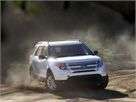
The 2011 Explorer comes in three models.
Ford offers the 2011 Explorer in base, XLT and Limited models. Standard equipment on the $28,190 base model includes, among other things, air conditioning, six-way power driver’s seat, cruise control, remote keyless entry, AM/FM/CD/MP3 stereo, auxiliary input jack, roof rails, 17-inch steel wheels. All-wheel drive adds another $2000, as well as front tow hooks and hill descent control.
The $33,190 XLT adds automatic headlights, leather-wrapped steering wheel, heated exterior mirrors, fog lights, rear park assist, keypad entry, Sirius satellite radio, and 18-inch alloy wheels.
The $37,190 Limited is loaded including dual-zone automatic climate control, leather upholstery, heated and power front seats, power adjustable pedals, keyless and remote starting, 110-volt power outlet, 12-speaker Sony audio system, rearview camera, and memory power seats, mirrors and pedals.
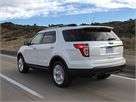
You'll want to and have to touch the Ford Explorer's interior
The last Explorer’s interior was utilitarian. Though it wasn’t inappropriate for the time or money, it featured a blocky design made up largely of hard, thick plastics. The American automakers have undergone an interior quality renaissance in the past year or so, and the new Explorer is a prime example.
Ford aimed to give the Explorer an expensive feel. While it may not be luxury car quality, it’s close and quite inviting. The design is more elegant, with a European look. You’ll find soft-touch surfaces on the dashboard, door panels and armrests, plus nice touches like metal speaker grilles, chrome accents and tight tolerances. We like it, but we’re not too enamored with the touch-sensitive controls on the center stack. Ford offers two versions, one branded by Sony. While both layouts are fairly simple, we prefer the traditional knobs and dials because you can rest your hand on them and keep your eyes on the road. For the touch controls, it takes some time to aim for the right settings, and if you rest your hand on the panel, you’ll probably accidentally hit one of the controls.
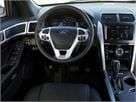
There's plenty of room for seven in the 2011 Ford Explorer
While the last Explorer offered two or three rows of seats, the 2011 model comes standard with three seating rows. Space inside is about the same, and that’s pretty darn good. The front row is comfortable and roomy. A standard tilt/telescoping steering wheel allows most drivers to find their natural seating position, and the Limited’s power adjustable pedals make it even easier. The front seats are comfortable, but lack bolstering to keep occupants from sliding around during hard cornering.
The second row is offered as a three-passenger bench or two captain’s chairs. The captain’s chairs are more comfortable, but the bench seat will allow you to carry more kids. The third row, which isn’t hard to access, has enough head and legroom for two adults. Low seat bottoms mean adults will sit with their knees at their chins though, so long trip comfort is lacking.
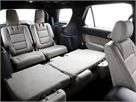
The 2011 Explorer will carry stuff, too
The Explorer’s second-row seat folds 60/40 (or 50/50 when captain’s chairs are ordered) and the third row folds 50/50, opening up 80.7 cubic feet of cargo room. That’s plenty of room for cargo, but the Chevrolet Traverse has a whopping 117 cubic feet of space. The area behind the third row is also oddly shaped. It has a well that extends partially under the third-row seats, so items might get stuck under there. We’d like to see a cover for this well and a rear cargo cover for the whole area. Making the third-row optional would add even more cargo space.
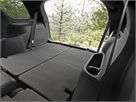
The 2011 Explorer offers an advanced communications and entertainment system.
The available MyFordTouch system provides a connection to cell phones and MP3 players and a control interface for those items, plus the trip computer, radio, navigation system, and climate functions. It comes with two USB ports, an SD card slot, RCA jacks, and three LCD screens. It is controlled via two five-way controllers on the steering wheel, by voice command, or by touch on the eight-inch screen in the center stack.
While MyFordTouch is at the forefront of connected technology, it takes awhile to learn the voice command structure, and the cadence can be annoying. I found myself giving it the next command before the system recognized the last one. It can also have trouble understanding some words. It may be high tech, but MyFordTouch still has plenty of room to grow.
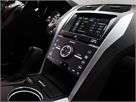
The 2011 Ford Explorer handles like a car
The new Explorer feels like an elevated car, not a cumbersome truck. The new unibody platform makes for a smooth ride and capable handling. In fact, the Explorer feels considerably smaller than its substantial size. Though taller than a car, it sits about two inches lower than the last model, which helps it lean less in turns. Ford had the new Jeep Grand Cherokee for comparison at the media drive, and the Explorer felt more agile, which is impressive because the Jeep handles amazingly well.
The Explorer’s electric assist power steering is light but sharp. The vehicle reacts quickly to driver inputs and gathers itself surprisingly well to head back in the other direction, which is helpful on twisty roads and in emergency maneuvers. Ford also programs the steering to compensate for the crown of a road, which means there are fewer little adjustments when driving on highways. Many automakers are developing electric power steering and Ford is doing it better than most.
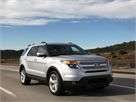
The New Explorer is pretty capable off-road
Order all-wheel drive and you get an electronic Terrain Management System that is similar to systems offered by Land Rover. It has four settings: Normal, Mud and Ruts, Sand and Snow. Each setting adjusts several vehicle systems to help the Explorer traverse that type of terrain. Specifically, it changes the transmission shift points, throttle response, front/rear torque bias, and electronic stability control program.
Ford had journalists drive the Explorer in some challenging off-road situations at California’s Hollister Hills State Vehicular Recreation Area. While the Explorer won’t compete with a Jeep Grand Cherokee for ultimate off-road ability, it proved quite worthy. The Snow setting retarded throttle response and shifted to a higher gear immediately to help get the Explorer moving on loose surfaces, while the Sand setting did just the opposite to keep it moving through sand. The standard hill descent control helped keep the vehicle controlled down steep hills, too. The Explorer may lack the tree stump-pulling power of a V8 and low-range gearing, but it will do most of what a family would need for an out-of-the-way vacation.
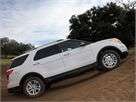
The 2011 Ford Explorer is a better idea
Ford claims it has reinvented the midsize SUV, but the change from truck-type SUVs to crossovers started years ago. Toyota did it with the Highlander in 2001, and General Motors made the change with the introduction of the Buick Enclave, GMC Acadia and Chevrolet Traverse starting in 2006. Ford has added some genuine off-road ability, though, and next year’s four-cylinder engine will make it even more fuel efficient. With plenty of room inside, a commanding seating position, decent towing capacity and all-wheel-drive security, the new Explorer has everything a family needs. It’s now far more fun to drive, too. These are all changes for the better, and we can certainly recommend this version far more than the last.
